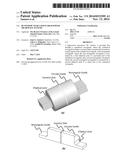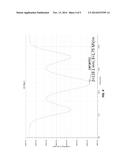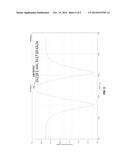Patent application title: RF window to be used in high power microwave systems
Inventors:
Sami G. Tantawi (Stanford, CA, US)
Valery A. Dolgashev (San Carlos, CA, US)
Anahid D. Yeremian (Menlo Park, CA, US)
IPC8 Class: AH01J2336FI
USPC Class:
333252
Class name: Long line elements and components waveguide elements and components window
Publication date: 2014-11-13
Patent application number: 20140333395
Abstract:
A high-power microwave RF window is provided that includes a cylindrical
waveguide, where the cylindrical waveguide includes a ceramic disk
concentrically housed in a central region of the cylindrical waveguide, a
first rectangular waveguide, where the first rectangular waveguide is
connected by a first elliptical joint to a proximal end of the
cylindrical waveguide, and a second rectangular waveguide, where the
second rectangular waveguide is connected by a second elliptical joint to
a distal end of the cylindrical waveguide.Claims:
1. A high-power microwave RF window, comprising: a. a cylindrical
waveguide, wherein said cylindrical waveguide comprises a ceramic disk
concentrically housed in a central region of said cylindrical waveguide;
b. a first rectangular waveguide, wherein said first rectangular
waveguide is connected by a first elliptical joint to a proximal end of
said cylindrical waveguide; and c. a second rectangular waveguide,
wherein said second rectangular waveguide is connected by a second
elliptical joint to a distal end of said cylindrical waveguide.
2. The high-power microwave RF window according to claim 1, wherein said high-power microwave RF window is capable of supporting a traveling wave inside said ceramic disk.
3. The high-power microwave RF window according to claim 1, wherein said high-power microwave RF window is capable of separating vacuum from atmospheric pressures in a klystron microwave system.
4. The high-power microwave RF window according to claim 1, wherein said high-power microwave RF window is capable of operating in a multi-tens-of-megawatt power environment.
5. The high-power microwave RF window according to claim 1, wherein said high-power microwave RF window is capable of minimizing a normal component of an electric field inside said ceramic disk, wherein a traveling wave is created inside said ceramic disk.
6. The high-power microwave RF window according to claim 1, wherein said high-power microwave RF window is capable of minimizing a surface magnetic and electric fields on the joints between the circular and rectangular waveguides.
Description:
CROSS-REFERENCE TO RELATED APPLICATIONS
[0001] This application claims priority from U.S. Provisional Patent Application 61/821,392 filed May 9, 2013, which is incorporated herein by reference.
FIELD OF THE INVENTION
[0003] The present invention relates generally to high power microwave systems. More specifically, it relates to RF window designs for high power microwave devices such as klystrons.
BACKGROUND OF THE INVENTION
[0004] RF windows are used to separate high and low vacuum regions in high power microwave systems, such as klystrons and RF distribution. RF breakdowns in megawatt environments could damage the window. What is needed is an RF window to reduce electric and magnetic fields in the waveguide joints and the ceramic.
SUMMARY OF THE INVENTION
[0005] To address the needs in the art, a high-power microwave RF window is provided that includes a cylindrical waveguide, where the cylindrical waveguide includes a ceramic disk concentrically housed in a central region of the cylindrical waveguide, a first rectangular waveguide, where the first rectangular waveguide is connected by a first elliptical joint to a proximal end of the cylindrical waveguide, and a second rectangular waveguide, where the second rectangular waveguide is connected by a second elliptical joint to a distal end of the cylindrical waveguide.
[0006] In one aspect of the invention, the high-power microwave RF window is capable of supporting a traveling wave inside the ceramic disk.
[0007] According to another aspect of the invention, the high-power microwave RF window is capable of separating vacuum from atmospheric pressures in a klystron microwave system.
[0008] In a further aspect of the invention, the high-power microwave RF window is capable of operating in a multi-tens-of-megawatt power environment.
[0009] According to one aspect of the invention, the high-power microwave RF window is capable of minimizing a normal component of an electric field inside the ceramic disk, wherein a traveling wave is created inside the ceramic disk.
[0010] In yet another aspect of the invention, the high-power microwave RF window is capable of minimizing a surface magnetic and electric fields on the joints between the circular and rectangular waveguides.
BRIEF DESCRIPTION OF THE DRAWINGS
[0011] FIGS. 1a-1b show perspective views of a high-power microwave RF window in full view and one quadrant view, according to one embodiment of the invention.
[0012] FIGS. 2a-2b show perspective views of a surface electric field on a window quadrant scaled for 65 MW power transmitted through the whole high-power S-band RF window, according to one embodiment of the invention. The fields here are shown for a specific window, field magnitudes will be different in case of different frequency bands.
[0013] FIGS. 3a-3b show perspective views of a surface electric field on a window quadrant scaled for 65 MW power transmitted through the whole high-power S-band RF window, according to one embodiment of the invention. The fields here are shown for a specific window, field magnitudes will be different in case of different frequency bands.
[0014] FIGS. 4-5 show plots of electric and magnetic fields on the centerline in the ceramic, respectively, according to one embodiment of the invention.
DETAILED DESCRIPTION
[0015] In ultra high power RF systems the window between vacuum and atmosphere is one of the components most prone to failure. Improving the reliability of this critical component in a high power environment will increase the reliability of the entire system and reduce the operation price.
[0016] In one aspect, the present invention provides a pillbox style RF window with elliptical joint between the circular and rectangular guide. Joint geometry is optimized to create a traveling wave inside the ceramic region and minimize the electric and magnetic field on the surfaces. The RF window is able to separate vacuum from atmosphere in high power microwave systems, such as klystrons. This window is designed to operate in multi-megawatt power environment without faults.
[0017] The current invention provides reduced electric and magnetic fields in ceramics and waveguide joints of RF windows. Specifically, the normal component of the electric field on the ceramic is minimized and a traveling wave is created inside the ceramic. This is achieved by optimizing the shape of the window and the geometry of the joint between the circular waveguide to the rectangular waveguide. The advantageous features of the window are achieved by optimizing the shape of the window and the geometry of the joint only and without additional matching elements. The matching elements increase complexity and decrease reliability, thus avoiding them is an important feature of this design. FIGS. 1a-1b show perspective views of a high-power microwave RF window in full view and one quadrant view, according to one embodiment of the invention.
[0018] This RF window design has superior performance compared to any existing windows in high power RF sources and RF particle accelerators. It is applicable for industrial, medical, military and research applications.
[0019] The design can be used at any frequency, first by scaling all dimensions and then making minor optimization due to variation in manufacturing techniques and material properties for the given frequency.
[0020] An exemplary high-power microwave RF window was built and successfully tested at SLAC for the ILC prototype L-band positron source. A large number of accelerators in the world, including the SLAC linac operate at S-band. Thus this window, which operates comfortably at 65 MW peak power in S-band, is of great importance for many accelerators. Particular attention was paid to mitigate the high fields on the ceramic and the metal. Trapped and so-called ghost modes were investigated to assure that such modes are outside klystron bandwidths. The present invention can replace the pair of windows in the current the 5045 klystrons by a single window of this design.
[0021] To minimize the fields on the ceramic, the traveling wave window approach was implemented, according to one embodiment of the invention. Here, the basic design requirements of the window and the values achieved in simulation are presented in Table 1.
TABLE-US-00001 TABLE 1 S-Band Window Design Parameters Parameter Required Achieved Frequency (MHz) 2856 2856 3 dB BW (MHz) ≧20 ≧100 Reflection (S11) <-20 dB <-70 dB Peak Power (MW) 65 MW 65 MW Peak E on Ceramic (MV/m) Minimize 1.75 Peak H on Ceramic (KA/m) Minimize 17 Peak E (MV/m) Minimize 11 Peak H (KA/m) Minimize 20
[0022] The ceramic is housed in a circular waveguide. We minimized the fields on the metal surfaces by optimizing the shape of the joint between the circular and rectangular waveguide. FIG. 1 shows a quadrant of the window.
[0023] To characterize the exemplary embodiment, namely the S-band version of the window, the commercial code Cascade was used for the initial simulations. Cascade uses mode-matching for rapid S parameter analysis and optimization of 2-port passive waveguide components and calculation of frequency and Q of resonators. The 3-D finite-element code HFSS was then used for the final design. For the nominal case of ε=9.6 and thickness of 4 mm the reflection at 2856 MHz is less than -90 dB and the bandwidth at -20 dB is 50 MHz and more than 100 MHz at -3 dB. The reflection is less than -45 dB at 2856 MHz at ±0.2 mm from nominal.
[0024] Regarding reflection vs. frequency for the window with varying permittivity of the ceramic, keeping the ceramic thickness at 4 mm, the ceramic permittivity is varied in ε=0.2 increments on either side of the nominal. The reflection is less than -35 dB at 2856 MHz in the worst case of ε=9.6±0.4, which is satisfactory for a practical design.
[0025] The maximum electric and magnetic fields on the metal appear on the elliptically-shaped joint between the circular and rectangular waveguides FIGS. 2a-2b show that at 65 MW through the window, the maximum electric field on the metal is 11 MV/m and the maximum electric field in the ceramic is 1.75 MV/m.
[0026] FIGS. 3a-3b show that the maximum magnetic field on the metal is 20 kA/m and on the ceramic it is 17 KA/m.
[0027] FIGS. 4-5 show plots of electric and magnetic fields on the centerline in the ceramic, respectively, according to one embodiment of the invention.
[0028] As a comparison, the SLAC 5045 klystron uses a dual window, and each window has a maximum electric field of 11.6 MV/m on the circular to rectangular waveguide joint and 3.3 MV/m on the ceramic and 11.6 MV/m on the circular to rectangular waveguide joint and 3.3 MV/m on the ceramic with half of 65 MW transmitted through it. The new design is a vast improvement considering that only one window is needed instead of two for the same function.
[0029] The trapped and ghost modes for this window were investigated. The study included the variation in the ceramic permittivity and thickness based on manufacturing variation. It was found that the nearest ghost mode is more than 200 MHz away from the nominal 2856 MHz. The closest trapped mode is more than 60 MHz away.
[0030] An exemplary S-band window is provided which comfortably operates at 65 MW, has much lower surface fields than the current S-band windows on the SLAC 5045 klystrons, and a single window of the design offered here can replace the dual window of the 5045.
[0031] The present invention has now been described in accordance with several exemplary embodiments, which are intended to be illustrative in all aspects, rather than restrictive. Thus, the present invention is capable of many variations in detailed implementation, which may be derived from the description contained herein by a person of ordinary skill in the art. For example the cross-section of the of the window could have other shape than circular, or shape of the joint between the input waveguide and the waveguide with a window could be modified to accommodate specific manufacturing process.
[0032] All such variations are considered to be within the scope and spirit of the present invention as defined by the following claims and their legal equivalents.
User Contributions:
Comment about this patent or add new information about this topic:
| People who visited this patent also read: | |
| Patent application number | Title |
|---|---|
| 20170061302 | CURIOSITY ADAPTIVE AMBIENT SEMANTIC INTELLIGENCE SYSTEM AND METHOD FOR SCIENTIFIC COLLABORATION |
| 20170061301 | LEARNING PARAMETERS IN A FEED FORWARD PROBABILISTIC GRAPHICAL MODEL |
| 20170061300 | SYSTEM AND METHOD FOR ANNOTATING AND RANKING REVIEWS WITH INFERRED ANALYTICS |
| 20170061299 | PREDICTION OF IN-FIELD DRY-DOWN OF A MATURE SMALL GRAIN, COARSE GRAIN, OR OILSEED CROP USING FIELD-LEVEL ANALYSIS AND FORECASTING OF WEATHER CONDITIONS AND CROP CHARACTERISTICS INCLUDING SAMPLED MOISTURE CONTENT |
| 20170061298 | Analyzing Social Media Posts and Campaigns |




